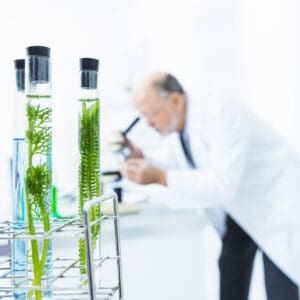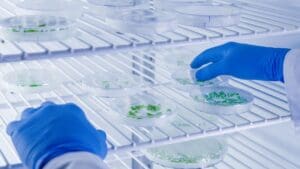Jump to:
– Applications
– Risks
– How automation can help
– Advice from our team
What is genome editing?
Genome editing, also known as genome engineering, genetic modification, or gene editing, refers to the insertion, deletion, or replacement of a DNA sequence within the genome of a living organism. Genome editing has several applications, including laboratory research tools, gene therapies, and genetic modification of crops. This article will discuss the applications, transformative potential, and challenges of agricultural gene editing, and how lab automation can help.
Genome editing applications in agriculture
Genome editing has vast potential in agriculture, allowing scientists and farmers to make precise changes to the DNA of crops to select advantageous traits1.
Gene editing of crops can target several complex challenges within agriculture, the environment, and health, benefiting farmers, breeders, society, and the planet.
Resistance to adverse conditions
In agriculture, editing the genomes of plants can be a practical way to protect crop yields by making them resistant to adverse conditions. This can include resistance to pests and common diseases that regularly affect crops. Genetic modification can render crops resistant to herbicides, meaning that farmers can treat crops to kill weeds but leave crops unaffected. Moreover, crops can be edited to resist suboptimal environmental conditions such as drought, extreme temperatures, and suboptimal soil conditions, which are likely to become more prevalent as the climate crisis progresses.
Enhanced nutritional content
Another use case for genome-edited crops is enhancing their nutritional content. For example, Golden Rice has been produced through genetic engineering to biosynthesise beta-carotene, a vitamin A precursor, aimed at helping to combat vitamin A deficiency in particular populations 2,3. Contrarily, genome editing technology in agriculture can reduce the natural production of factors that are not nutritionally beneficial, such as phytic acid in beans, which inhibits mineral absorption.
Reducing allergens
Similarly, crops can be genetically edited to reduce their allergen production, which is advantageous for sensitive individuals.
Improved crop yield and farming productivity
Genetic modification of genes that contribute to plant growth can be employed to improve the yield of certain crops. It can also be used to alter crop growth patterns, for example, by reducing the height of tall crops that often fall over, enhancing farming efficiency and productivity, and driving increased profits for farmers.
Environmental conservation
Crops can be modified to thrive with less water, pesticides, and fertilisers, rendering agricultural processes more sustainable and environmentally friendly.
Extended shelf life
In another effort to increase farming sustainability, crops can be edited to have a longer shelf life, reducing food waste. An example of this is tomatoes, which have been engineered to have reduced levels of a pectin-breakdown enzyme called polygalacturonase.
What are the risks of genome editing in agriculture?
Despite the many benefits of genome-edited crops that have the potential to address challenges such as climate change, food security, and population health, there are significant technical, ethical, and ecological risks that hinder widespread adoption 1,4.
Some of the major issues in agriculture genome editing include 5:
- Off-target gene modification: There is the concern that genome editing may result in off-target mutations leading to undesirable genetic changes. However, these are generated by current genome-editing technology at a similar frequency to naturally occurring mutations. Furthermore, future improvements in the fidelity of genome editing processes could reduce mutation frequency
- Technical challenges: Gene editing of crops is technically complex, and there are associated risks that require appropriate stewardship. However, there is often a lack of stewardship which can be problematic. As genome editing technology in agriculture advances, it is likely to become simpler and less technically demanding, reducing the associated risks and requirement for close monitoring
- Lack of transparency: A particular ethical concern surrounding genome editing is a lack of transparency regarding the processes and the products. This problem is responsible for a certain level of mistrust in genetically modified crops, and improved transparency would likely foster more widespread acceptance and adoption
- Regulatory challenges: A considerable challenge in producing genetically modified crops and getting them to market is the need for regulatory approval, which can be challenging given the infancy of the practice and the current lack of clarity within the regulatory landscape 5
How can automation help?
Automation can be incorporated to improve genome editing practices in the agrigenomics space. Not only does it enhance precision and efficiency, but it also improves scalability and accelerates research, allowing faster improvements in genome editing technology in agriculture.
Automation within data flows can also support better contextualisation of results, improving repeatability and documentation, both vital for regulatory industries like food production.
Enhanced scalability
Automating aspects of genome editing workflows, using integrated solutions such as Automata’s LINQ, enables processes to be effectively scaled 4. This is particularly important in enabling more advanced genome editing technologies to be developed, as well as in scaling crop editing to combat food insecurity 1.
Faster, more efficient processes
Similarly, automating processes is more efficient than manual processes. This fast-tracks the development of novel or adapted gene editing technologies to help overcome technical challenges. It can also speed up the lengthy testing processes, such as genomic sequencing, required when producing a novel variant of a crop for the first time, reducing the time and cost investment involved.
Traceability and documentation
Integrating automation hardware such as the LINQ Bench with software such as the LINQ Cloud enables automatic documentation of the entire process. This can reduce the risk of recording errors and improve the comprehensiveness of documentation, which could prove useful in adhering to regulatory guidance and obtaining approval.
Interested in how Automata’s automation solutions could improve your agricultural genome editing workflows? Check out our products or get in touch today!
References
1. Pixley KV, Falck-Zepeda JB, Paarlberg RL, et al. Genome-edited crops for improved food security of smallholder farmers. Nat Genet. 2022;54(4):364-367. doi:10.1038/s41588-022-01046-7
2. Tang G, Qin J, Dolnikowski GG, Russell RM, Grusak MA. Golden Rice is an effective source of vitamin A. Am J Clin Nutr. 2009;89(6):1776-1783. doi:10.3945/ajcn.2008.27119
3. Underwood BA, Arthur P. The contribution of vitamin A to public health. FASEB J. 1996;10(9):1040-1048. doi:10.1096/fasebj.10.9.8801165
3. Jansing J, Schiermeyer A, Schillberg S, Fischer R, Bortesi L. Genome Editing in Agriculture: Technical and Practical Considerations. Int J Mol Sci. 2019;20(12):2888. doi:10.3390/ijms20122888
4. Lassoued R, Macall DM, Smyth SJ, Phillips PWB, Hesseln H. Risk and safety considerations of genome edited crops: Expert opinion. Curr Res Biotechnol. 2019;1:11-21. doi:10.1016/j.crbiot.2019.08.001

Automata Senior Application Scientist Alice Tome-Fernandez discusses how to achieve more throughput…
Read more Scaling throughput in agrigenomics labs with automation
Gene-editing technology such as CRISPR could be the future of agriculture. We…
Read more CRISPR in agriculture: applications, benefits & risks
Genomics is transforming the future of agriculture. Learn how open, integrated automation…
Read more Agrigenomics: the role of automation